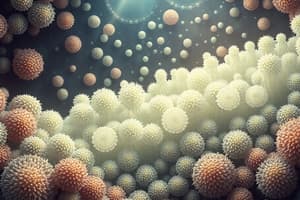Podcast
Questions and Answers
What is the initial stage of biofilm formation called when free-floating microbes first attach to a surface?
What is the initial stage of biofilm formation called when free-floating microbes first attach to a surface?
- Microcolony formation stage
- Mature biofilm stage
- Irreversible attachment stage
- Reversible attachment stage (correct)
What type of structures and substances are crucial for irreversible attachment in biofilm formation?
What type of structures and substances are crucial for irreversible attachment in biofilm formation?
- Cell walls and membranes
- Flagella and spores
- Capsules and toxins
- Adhesins and fimbriae (correct)
Which of the following locations is NOT typically associated with biofilm formation?
Which of the following locations is NOT typically associated with biofilm formation?
- Toilet bowls
- Teeth surfaces
- Rocks in creeks and streams
- Inside sterile laboratory containers (correct)
Which factor is NOT influencing the reversible attachment stage of biofilms?
Which factor is NOT influencing the reversible attachment stage of biofilms?
During quorum sensing, what key process do microbial communities undergo?
During quorum sensing, what key process do microbial communities undergo?
What action is typically required to prevent the quick reformation of biofilms after mechanical removal?
What action is typically required to prevent the quick reformation of biofilms after mechanical removal?
Biofilms can consist of which types of microbes?
Biofilms can consist of which types of microbes?
What can biofilms participate in regarding environmental processes?
What can biofilms participate in regarding environmental processes?
Which type of quorum sensing (QS) system is characterized by the use of acyl-homoserine lactones (AHLs)?
Which type of quorum sensing (QS) system is characterized by the use of acyl-homoserine lactones (AHLs)?
What is unique about the signaling in Luxl/LuxR-type QS systems and the two-component oligopeptide class?
What is unique about the signaling in Luxl/LuxR-type QS systems and the two-component oligopeptide class?
Which organism is a well-studied example of biofilm colonization through Luxl/LuxR-type QS?
Which organism is a well-studied example of biofilm colonization through Luxl/LuxR-type QS?
In the experiment aimed at investigating biofilm formation, why will the planktonic cells be washed away?
In the experiment aimed at investigating biofilm formation, why will the planktonic cells be washed away?
What is the role of extracellular polymeric substance (EPS) in biofilm maturation?
What is the role of extracellular polymeric substance (EPS) in biofilm maturation?
How does biofilm development change the structure of the community?
How does biofilm development change the structure of the community?
What is quorum sensing (QS) primarily associated with in biofilms?
What is quorum sensing (QS) primarily associated with in biofilms?
What are autoinducers (Als) in the context of biofilms?
What are autoinducers (Als) in the context of biofilms?
What makes biofilms particularly resistant to antibiotics?
What makes biofilms particularly resistant to antibiotics?
Which chronic human infection is NOT typically associated with biofilms?
Which chronic human infection is NOT typically associated with biofilms?
What is a potential outcome of the accumulation of autoinducers in a biofilm?
What is a potential outcome of the accumulation of autoinducers in a biofilm?
What impact did the discovery of biofilm antibiotic resistance have on medical treatments?
What impact did the discovery of biofilm antibiotic resistance have on medical treatments?
How does biofilm formation affect the expression of genes in planktonic versus biofilm forms of bacteria?
How does biofilm formation affect the expression of genes in planktonic versus biofilm forms of bacteria?
What factor contributes to the survival strategies of biofilm communities?
What factor contributes to the survival strategies of biofilm communities?
Flashcards are hidden until you start studying
Study Notes
Biofilm Formation
- Biofilms are communities of microbes found on living and nonliving surfaces where water and nutrients are abundant.
- They consist of bacteria, fungi, algae, and protozoa.
- Biofilm formation involves a series of steps:
- Reversible Attachment: Planktonic microbes loosely attach to a surface, influenced by factors like temperature and pH.
- Irreversible Attachment: Microbes firmly attach to the surface using adhesins, fimbriae, and curli.
- Microcolony Formation: Microbes reproduce and form small colonies.
- Maturation: Microbes produce an extracellular polymeric substance (EPS) composed of sugars, proteins, and nucleic acids. EPS binds cells together and forms a 3D structure.
- Transmission: Biofilm propagates by dispersing clumps or individual cells.
- Biofilms exhibit distinct behaviors compared to planktonic cells, including different gene expression patterns.
- Quorum sensing (QS) is a density-dependent communication system within biofilms.
- Autoinducers (AIs) are signal molecules produced by biofilm members that accumulate within the EPS, triggering gene expression when a threshold concentration is reached.
- QS can occur between cells of the same species and different species.
- QS contributes to various biological processes, including symbiotic relationships, spore formation, competence, apoptosis, and virulence.
Importance of Biofilms
- Biofilms are highly resistant to antibiotics (up to 1000 times greater than planktonic cells).
- Biofilms are implicated in chronic human infections, such as middle ear infections, diabetic foot ulcers, stomach ulcers, and recurrent pneumonia in cystic fibrosis patients.
- Biofilms affect natural environments by contributing to food webs, bioremediation, and plant-microbe symbiosis.
- Biofilms can cause problems in water-based processes, including pipe blockage, corrosion, and water contamination.
Quorum Sensing Systems
- QS involves the interaction of a bacterial signal molecule with a transcriptional activator.
- Three main QS systems:
- LuxI/LuxR-type: Uses acyl-homoserine lactones (AHLs) as signal molecules in gram-negative bacteria.
- Two-component-type: Uses small oligopeptides as signal molecules in gram-positive bacteria.
- LuxS-encoded autoinducer-2 (AI-2): Found in both gram-negative and gram-positive bacteria, allowing interspecies communication.
Example of QS: Hawaiian Bobtail Squid
- The squid is colonized by biofilms of the gram-negative bacterium Aliivibrio fischeri.
- A. fischeri uses LuxI/LuxR-type QS to control various processes.
- Hundreds of gram-negative bacteria use this system, producing unique AHLs for intraspecies communication.
- Only the AI-2 system enables interspecies communication.
Biofilm Assay
- This experiment investigates the ability of environmental isolates to form biofilms on abiotic surfaces.
- Isolates are grown in a 96-well microtiter plate for 48 hours.
- Planktonic cells are removed by washing.
- Attached cells are stained with a dye, and the plate is dried after dye removal.
- The experiment aims to correlate biofilm data with previous experiments and predict the type of QS system present in the environmental isolate.
Studying That Suits You
Use AI to generate personalized quizzes and flashcards to suit your learning preferences.




